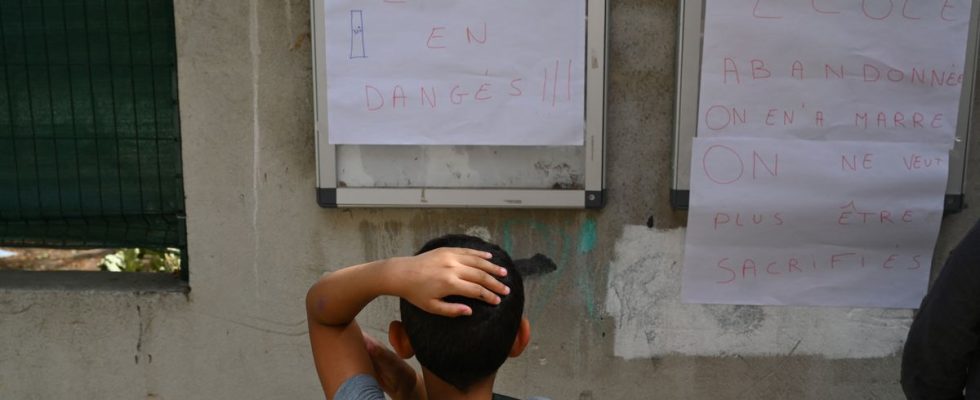Episodes that marked the spirits. In 2019, the patent tests had been postponed due to the heat wave. Last year, the written exams for the baccalaureate also took place during a heat wave, hence the strict instructions given to the heads of establishments to limit the inconvenience. That’s not all: this winter, several media relayed cases of very poorly insulated schools, including a high school in Aulnay-sous-Bois where the thermometer did not exceed 11 ° C.
In response, Emmanuel Macron announced last weekend, in an interview with Parisian, a “big plan” for the energy renovation of establishments, with financial aid to put an end to thermal sieves. The stakes are high since schools represent 40% of public buildings. The president is not the only one to take up the subject, the Senate having launched an information mission on “School buildings put to the test of ecological transition”, the conclusions of which will be delivered at the end of June.
Nearly 10% of very dilapidated establishments
This will be an opportunity to make a first diagnosis of the state of school buildings, because there is no general inventory of fixtures concerning the 48,557 schools, 6,962 colleges and 3,716 high schools in France. In particular because their renovation and maintenance fall under the prerogatives of different local authorities (municipalities for schools, departments for colleges, regions for high schools). Asked by 20 minutes, the Ministry of Education declares that according to its “school building” unit, which met with associations of elected officials and nearly 300 local authorities, “the share of schools with significant dilapidation is estimated at 10% . And the share of those who have already benefited from an energy renovation is estimated at 20%. “. This does not mean that other schools, colleges and high schools do not require work.
Nadège Havet, senator from Finistère, is the rapporteur for the Senate fact-finding mission: “The situation is very disparate from one establishment to another. And a 100-year-old school can consume less energy than a 20-year-old middle school.” that “Marseille is one of the municipalities where the school building is the most deteriorated. »
Very important works to be planned
In schools, colleges and high schools which must undergo a serious facelift, the work to be planned is important: insulation, change of heating methods, ventilation work, replacement of lighting with LEDs, creation of islands of freshness in the courtyards, even installation of photovoltaic panels.
“A renovation project is also an opportunity to question the uses of the premises with the teachers. In some establishments, we do not necessarily need as many classes, but larger classes to ensure 3 m2 per student. Because the Covid-19 crisis has highlighted the impossibility of ensuring social distancing in certain buildings”, underlines Nadège Havet. Delphine Labails agrees: “We must not limit ourselves to the renovation of the classrooms and the greening of the courtyard, but also to review the canteen, the toilets… And adapt the premises to all types of disabilities (motor, visual, auditory…) . »
“These are pharaonic sums that must be planned”
Multiple works that make the bill soar. Delphine Labails cites an example: “The renovation of a school made up of 5 classes, a canteen, a courtyard, a multi-purpose room costs 3 million euros. Nadège Havet also did the accounts: “It takes between 350 and 450 euros per square meter. These are pharaonic sums that must be expected. It would take 40 billion to renovate all French school buildings over ten years, or 4 billion per year”.
To finance the work, several mechanisms exist. Local authorities can first apply for the local investment support grant (DSIL), the rural area equipment grant (DETR) or the departmental investment support grant (DSID). Funding that represents 2 billion euros per year since 2018, according to the Report on the energy renovation of school buildings published in 2020. According to the Ministry of Education, “the energy renovation component of the recovery plan also made it possible to finance the energy renovation of 3,500 schools in 2021 and 2022, for a total investment of nearly 2 billion euros “.
Great expectations from communities
For the time being, all this aid seems insufficient. “For the schools, the work is sliced up according to the funding that the municipalities can release. And the smallest towns suffer from a lack of engineering to implement this work,” notes Nadège Havet. To receive this or that endowment, the mayors must indeed respond quickly to calls for projects, which is not always possible, due to a lack of time or expertise available. Local authorities are also reluctant to invest massively in certain establishments, which are sometimes suspended at the risk of closure due to the demographic decline.
This shows how much they have great hopes in the plan announced by Emmanuel Macron. “We had been asking for such a device to renovate schools for two years. We will be vigilant that rural municipalities benefit from the same support as large cities”, warns Delphine Labails. “Small municipalities must also be able to rely on shared energy advisers to help them make a diagnosis of the most urgent work to be carried out and put together funding application files,” insists Nadège Havet.

